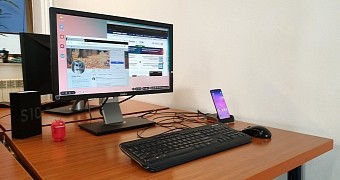Microsoft’s Surface Duo is official now, and customers can pre-order one right away, with shipping projected to begin on September 10.
Needless to say, the launch of the Surface Duo is a key moment for Microsoft, not only because it’s an Android device but also because it marks the company’s return to the mobile hardware game.
While Windows 10 Mobile has been a dead platform for several years already, the mobile operating system was officially abandoned only a few months ago when Microsoft stopped releasing updates to the handful of devices still in use out there.
And while Windows 10 Mobile devices are pretty much useless right now, unless you just want to make phone calls and send texts, some of them actually came with a feature that the Surface Duo needs too. And if you ask me, it should have been there from the very beginning.
Microsoft doesn’t necessarily describe the Surface Duo as a mobile phone, but as a dual-screen device focused on mobile productivity.
As Microsoft watchers know already, Microsoft has made an obsession about productivity on all its platforms, but as far as the Surface Duo is concerned, there’s one key feature in this regard that’s missing: it’s the possibility of connecting the Android device to a bigger screen and working just like you do on a computer.
Windows 10 Mobile devices came with Continuum, a feature that required just a small adapter to be able to run on a larger screen, such as a PC monitor, and offer a “desktop” version of the operating system that allowed people to work with a mouse and keyboard connected via USB. Since Windows 10 Mobile was supposed to be an extension to Windows 10, this simulated desktop experience was very familiar for PC users, and needless to say, was something that perfectly aligned with this push for productivity.
While Continuum is obviously no longer possible in the Android world, Google’s mobile operating system too comes with support for such functionality. And the living proof is none other than Samsung’s DeX, which itself is an alternative to Continuum for Android users that simulates a desktop experience with support for mice and keyboards and the possibility of running everything on a larger screen.
At first glance, it makes sense for Microsoft not to offer a desktop experience on an Android device, simply because it already offers something similar in the Windows world, and technically, the company could end cannibalizing its own product, but as far as productivity is concerned, this is something that should have been there from the very beginning.
Microsoft is actually trying a different approach that wouldn’t impact the Windows 10 desktop, but instead boost its adoption. It’s support for Android apps right on the desktop, an idea that’s powered by the Your Phone app that comes pre-loaded with Windows 10.
Technically, Your Phone now allows users to run some of their Android apps installed on the mobile phone right on their PC, even offering tools like separate windows and options to pin them to the taskbar. This is for many a much more advanced solution than Continuum than DeX, but on the other hand, it’s something that first of all, requires Windows 10, and second of all, doesn’t support all apps.
Samsung’s DeX is right now the best implementation of an experience that continues beyond the phone and expands to a bigger screen, and someone interested in productivity should really check it out. If Your Phone evolves to provide Surface Duo users with a worthy replacement is something that remains to be seen, but right now, I can’t help but miss Windows Phone, my Lumia 950, live tiles, and Continuum.

 14 DAY TRIAL //
14 DAY TRIAL //